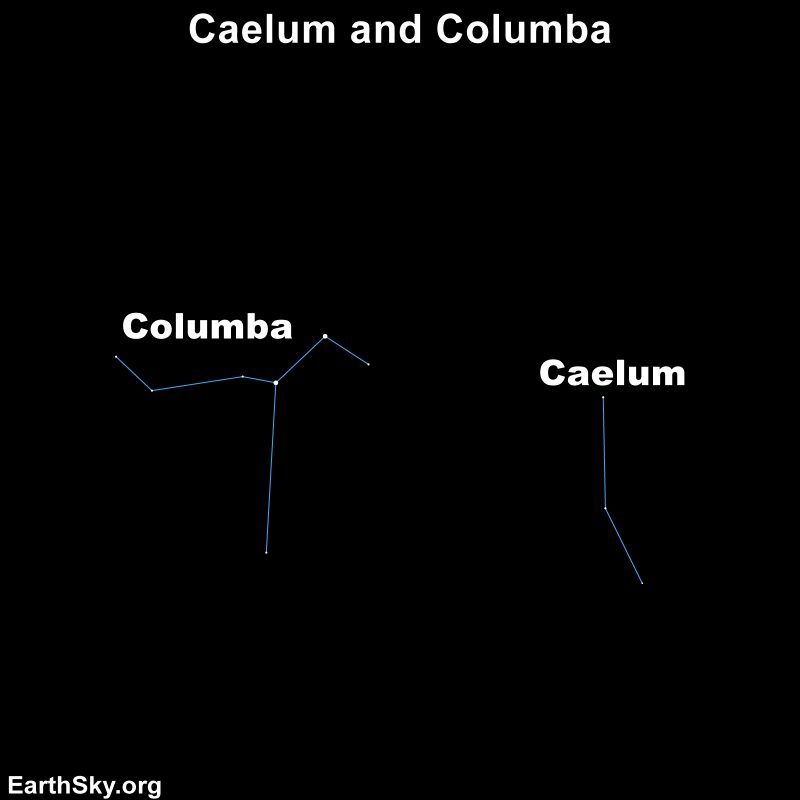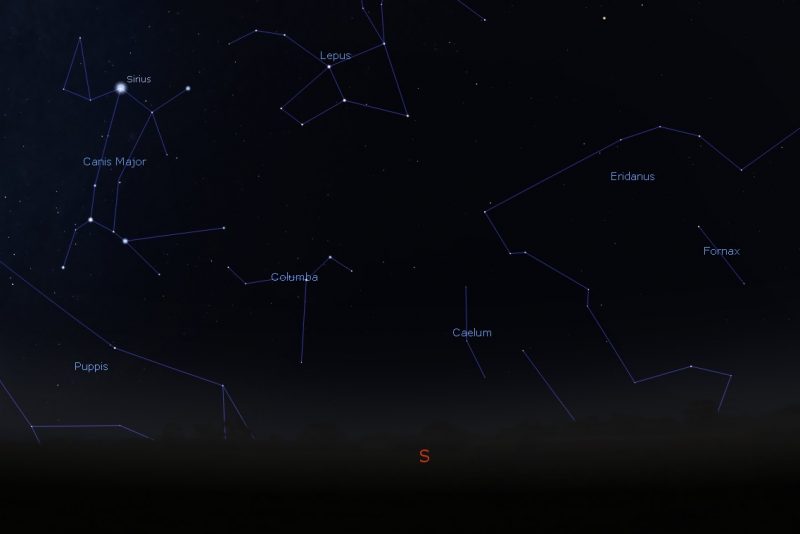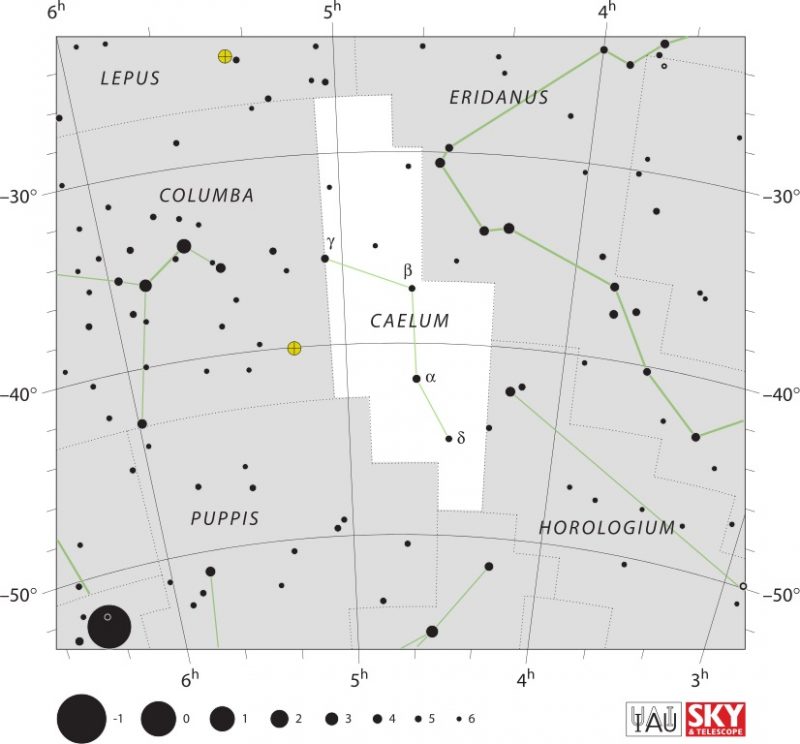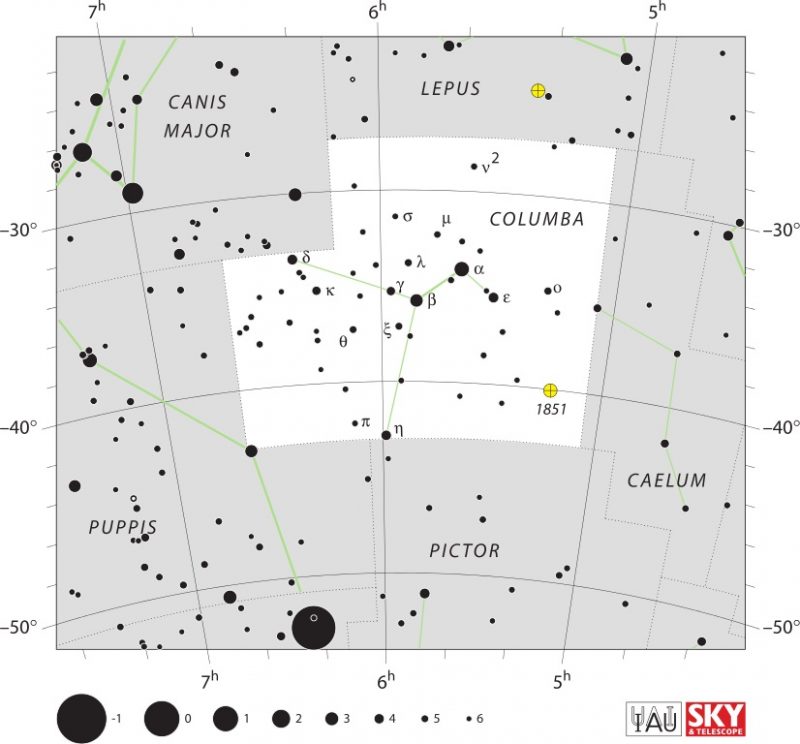
Columba the Dove and Caelum the Chisel are dim Southern Hemisphere constellations that some northerners can glimpse on January and February evenings. Observers in southerly regions of the Northern Hemisphere can spot the pair close to the southern horizon. Both constellations are well below the feet of Orion the Hunter, with Lepus the Hare separating Orion and the two petite constellations.
Caelum rises first, with Columba following. Columba is about twice the size of Caelum, but still on the small side. Out of the 88 constellations, Columba is 54th in size and Caelum is 81st.
Residents of the middle section of the United States – from about the 40th parallel – and southward can see the constellations brushing the southern horizon during mid-evening in deep winter. From the Southern Hemisphere, these two constellations pass overhead in January and February during evening hours.
The 2022 lunar calendars are here. Order yours before they’re gone!

The stars of Caelum the Chisel
The shape of the sculptor’s chisel is a challenge for anyone to discern, because the constellation has only one star that is 4th magnitude, with the rest being dimmer. The brightest star in the constellation is Alpha Caeli at magnitude 4.44, lying 66 light-years away.
About 8 degrees to the northeast is the 2nd brightest star, which is part of a double star. Gamma 1 Caeli has magnitude 4.55 and lies 185 light-years away. Gamma 2 Caeli has a magnitude of 6.32 and lies 13 arcminutes away from Gamma 1. The distance from us to Gamma 2 is 334 light-years, about twice as far away as Gamma 1, revealing that the two are not a physical pair but merely a line-of-sight grouping.
While there aren’t any good deep-sky observing targets in Caelum for binocular or telescope owners, there is one curiosity lurking in its depths.
Scientists think there might be a supercluster of galaxies in the direction of Caelum some 2 billion light-years away. It may contain 50,000 giant galaxies and 500,000 dwarf galaxies and span 910 million light-years. Although still circumstantial, it could be the largest galaxy supercluster in the universe.

The stars of Columba the Dove
Columba the Dove is south of Orion and Lepus and west of the brightest star Sirius in its constellation Canis Major the Greater Dog. Caelum is to Columba’s west.
Columba’s brightest star is Alpha Columbae, or Phact, at magnitude 2.65. Phact lies 268 light-years away. Three degrees to the southeast of Phact is Beta Columbae, or Wazn, at magnitude 3.12. Wazn lies 86 light-years away. About 10 degrees south of Phact is Eta Columbae, a magnitude 3.96 star that lies 531 light-years away.
Two more semi-bright stars are in Columba. The first is back near Phact, just two degrees to its southwest. This is Epsilon Columbae at magnitude 3.86, which lies 277 light-years away. The second is about nine degrees east of Phact. This magnitude 3.85 star is Delta Columbae, lying 237 light-years away.
Columba lies on the fringes of where we see the Milky Way galaxy on the dome of our sky. One of the few deep-sky targets in Columba is NGC 1851, a globular cluster in the southwest corner of the constellation. NGC 1851 is magnitude 7.3 and lies 39,500 light-years away. It has one of the densest cores for a globular cluster.

Bottom line: The small constellations of Caelum the Chisel and Columba the Dove cross high overhead for observers in the Southern Hemisphere on January and February evenings. But those in the Northern Hemisphere aren’t completely shut out. For those in more southerly areas of the Northern Hemisphere, you can spot the two constellations scraping the southern horizon during this time of year.
The post Caelum and Columba in January and February first appeared on EarthSky.
0 Commentaires